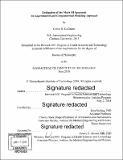| dc.contributor.advisor | Leia Stirling. | en_US |
| dc.contributor.author | Cullinane, Conor R. (Conor Ryan) | en_US |
| dc.contributor.other | Harvard--MIT Program in Health Sciences and Technology. | en_US |
| dc.date.accessioned | 2018-09-17T15:49:00Z | |
| dc.date.available | 2018-09-17T15:49:00Z | |
| dc.date.copyright | 2018 | en_US |
| dc.date.issued | 2018 | en_US |
| dc.identifier.uri | http://hdl.handle.net/1721.1/117896 | |
| dc.description | Thesis: Ph. D., Harvard-MIT Program in Health Sciences and Technology, 2018. | en_US |
| dc.description | Cataloged from PDF version of thesis. | en_US |
| dc.description | Includes bibliographical references (pages 114-118). | en_US |
| dc.description.abstract | Spacesuit Assemblies (SSAs) provide life support for human operators performing extravehicular activities (EVAs). The overall goal of this research was to investigate three research questions to address gaps in the field of spacesuit assembly (SSA) evaluations: [1] What are the mobility and agility limitations causing operators to experience performance decrements when wearing a SSA?; [2] What is causing operators to experience increased joint torques?; and [3] How does the distributed weight of an SSA, transferred to the operator, affect performance? This research leveraged both experimental and computational modeling capabilities to evaluate SSAs with a human-centered focus, in ways previously unachievable. The space suit evaluated for this research was NASA's Mark III (MkIII) Planetary Technology Demonstrator SSA, built to test the next generation in planetary exploration capabilities, improving upon Apollo era technology. The hip brief assembly (HBA) is built with three nested bearings, each with a single rotational degree of freedom that together provide the range of motion, walking efficiency, and kneeling capabilities. An initial investigation, combining a pilot study and supporting modeling, revealed limitations in the current human-SSA system that may impair the operator's mobility/stability and agility. Limitations identified and investigated in this thesis include SSA degrees of freedom (DOFs), the SSA range of motion (ROM) envelope, the bearing resistances, the SSA component's inertial effects, the SSA mass load transfer dynamics, and suit fit. The SSA architecture was modeled as part of the thesis, creating a tool that was useful in the investigation of the human-suit system. The model relied on SSA component geometries and inherent mass/inertia and bearing resistance characteristics to output joint dynamics, rather than requiring those dynamics as an input (which would require extensive experimental setups). The model was used to isolate components that contribute to the measured operator performance degradations and to quantify the extent of their contributions. These investigations lead to suggestions for design requirements and evaluation techniques that can guide future SSA development and evaluations. | en_US |
| dc.description.statementofresponsibility | by Conor R. Cullinane. | en_US |
| dc.format.extent | 142 pages | en_US |
| dc.language.iso | eng | en_US |
| dc.publisher | Massachusetts Institute of Technology | en_US |
| dc.rights | MIT theses are protected by copyright. They may be viewed, downloaded, or printed from this source but further reproduction or distribution in any format is prohibited without written permission. | en_US |
| dc.rights.uri | http://dspace.mit.edu/handle/1721.1/7582 | en_US |
| dc.subject | Harvard--MIT Program in Health Sciences and Technology. | en_US |
| dc.title | Evaluation of the Mark III spacesuit : an experimental and computational modeling approach | en_US |
| dc.type | Thesis | en_US |
| dc.description.degree | Ph. D. | en_US |
| dc.contributor.department | Harvard University--MIT Division of Health Sciences and Technology | |
| dc.identifier.oclc | 1051214768 | en_US |
